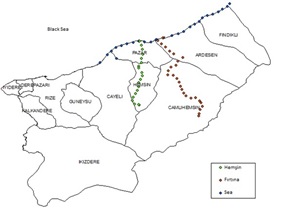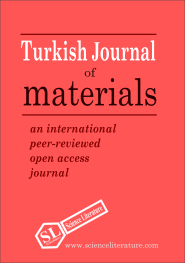
Assessments of Tritium Concentration in the Some Water Samples around Rize
Abstract
Full Text:
PDFReferences
UNSCEAR. Sources and effects of ionising radiation: sources and biological effects: report to the General Assembly with annexes. New York: United Nations Scientific Committee on the Effects of Atomic Radiation (1982).
S. Kaufman, W. Libby. The natural distribution of tritium. Phys. Rev. 93 (1954) 1337–1344.
S. Okada, N. Momoshima. Overview of tritium – characteristics, sources, and problems. Health Phys. 65 (1993) 595–609.
M. Puhakainen, T. Heikkinen. Tritium in the urine in Finnish people. Radiat. Prot. Dosimetry. 128 (2008) 254–257.
UNSCEAR. Sources, effects and risks of ionizing radiation: report to the general assembly with annexes. New York: United Nations Scientific Committee on the Effects of Atomic Radiation; (1988).
F. Eyrolle, L. Ducros, S.L. Dizès, K.B.-Seiller, S. Charmasson, P. Boyer, C. Cossonnet. An updated review on tritium in the environment. J. Environ. Rad., 181 (2018) 128-137.
P. Belloni, G.F. Clemente, S. Di Pietro, G. Ingrao. Tritium levels in blood and urine samples of the members of the Italian general population and some exposed subject. Radiat. Prot. Dosimetry. 4 (1983) 109–113.
C.N. Cawley, B.A. Lewis, L.A. Cannon. Possible parameters in the urinary excretion of tritium. Trans. Am. Nucl. Soc. 50 (1985) 39–44.
R.L. Hill, J.R. Johnson. Metabolism and dosimetry of tritium. Health Phys. 65 (1993) 628–647.
ICRP. Protection of the public in situations of prolonged radiation exposure. ICRP Publication 82, Ann. ICRP 29. Ottawa: International Commission on Radiological Protection (1999).
E.L. Etnier, C.C. Travis, D.M. Hetrick. Metabolism of organically bound tritium in man. Radiat. Res. 100 (1984) 487– 502.
DNEPI. Nükleer santraller ve ülkemizde kurulacak nükleer santrale ili¸skin bilgiler. Department of nuclear energy project implementation, publication no:2. Republic of Turkey: Ministry of Energy and Natural Resources (2012).
ABPRS. Address based population registration system. Turkey: Turkish Statistical Institute (2017).
N. Momoshima, Y. Nagasato, Y. Takashima. A sensitive method for the determination of tritium in urine. J. Radioanal. Nucl. Chem. Lett. 107 (1986) 353–359.
Y. Ujeno, K. Yamamoto, T. Aoki, N. Kurihara. Tritium content in tissue free water of Japanese bodies. Radiat. Prot. Dosimetry. 16 (1986) 181–183.
L.A. Currie. Limits for qualitative detection and quantitative determination. Anal. Chem. 40 (1968) 586–593.
M. Palomo, A. Peñalver, C. Aguilar, F. Borrull. Tritium activity levels in environmental water samples from different origins. Appl. Radiat. Isot. 65(9) (2007) 1048-56.
N. Momoshima, T. Kaji, I.T. Poppy, N. Inoue, Y. Takashima. Tritium concentrations of river water on northern and southern islands of Japan. Journal of Radioanalytical and Nuclear Chemistry, 150 (1991) 163.
K. Marianna, D. Alena, Tritium in the Water Environment of Baltic Sea basin. 2010 International Conference on Biology, Environment and Chemistry (IPCBEE) IACSIT Press, Singapore, 1 (2011).
L. Ducros, F. Eyrolle, C. D. Vedova, S. Charmasson, M. Leblanc, A. Mayer, M. Babic, C. Antonelli, D. Mourier, F. Giner, Tritium in river waters from French Mediterranean catchments: Background levels and variability, Science of The Total Environment, 612, (2018), 672-682.
Ravikumar P. Somashekar RK. Environmental tritium (³H) and hydrochemical investigations to evaluate groundwater in Varahi and Markandeya river basins, Karnataka, India. J. Environ. Radioact. 102(2) (2011) 153-62.
P.A. Harms, A. Visser, J. E. Moran, B.K. Esser, Distribution of tritium in precipitation and surface water in California, Journal of Hydrology, 534 (2016), 63-72.
A. Cauquoin, P. Jean-Baptiste, C. Risi, É. Fourré, B. Stenni, A. Landais, The global distribution of natural tritium in precipitation simulated with an Atmospheric General Circulation Model and comparison with observations, Earth and Planetary Science Letters, 427 (2015) 160-170.
L. Currivan, K. Kelleher, P. McGinnity, J. Wong and C. McMahon. A survay of tritium in Irish seawater. Radiologinal Protection Institute of Ireland, RPII 13/02 (2013) 30.
N. İpek. Determination of the Tritium Level in Some Rivers and Sea Water Samples in Rize. Master Thesis. Recep Tayyip Erdogan University, Institute of Science and Technology, Rize, Turkey, (2015) 84.
Copyright (c) 2018 Turkish Journal of Materials

This work is licensed under a Creative Commons Attribution-NonCommercial 4.0 International License.
Indexing:








